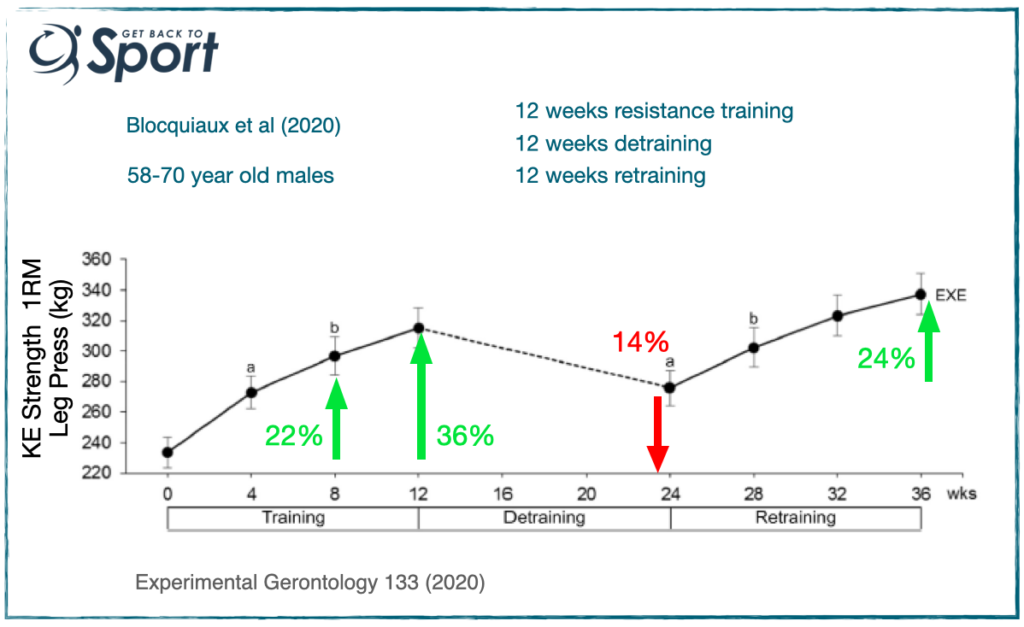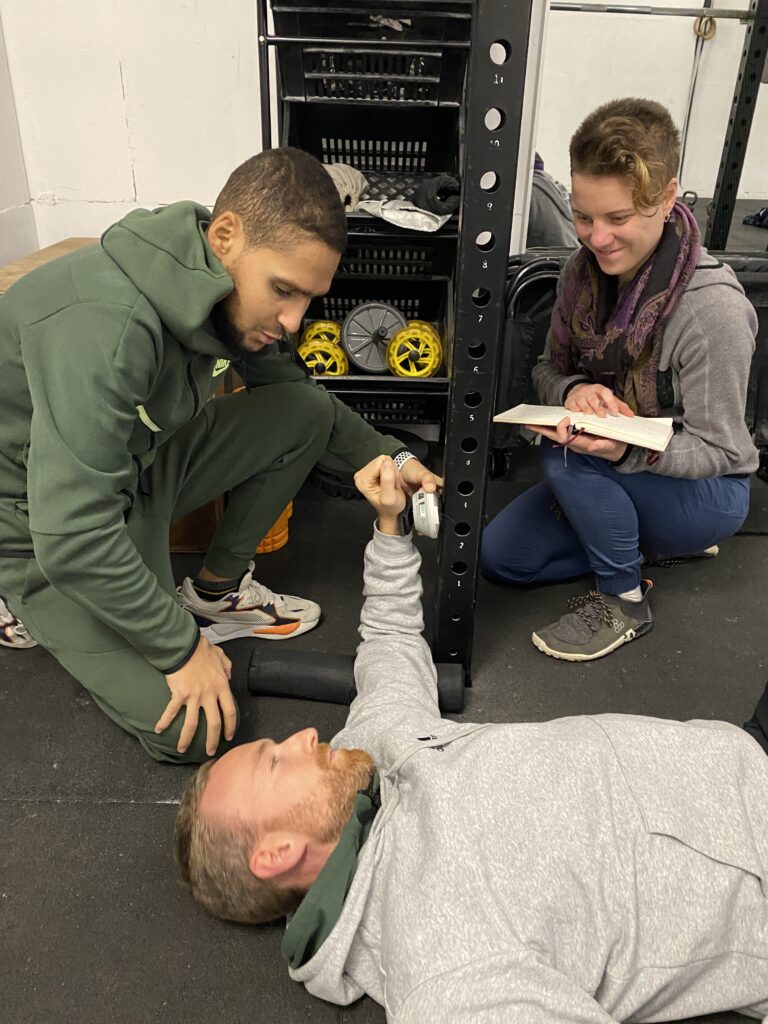Welcome to post 44 of Strength & Conditioning for Therapists. We’re approaching 4 weeks into lockdown here in the UK and I’m sure the situation isn’t too different for you if you’re base elsewhere. Clearly we’re not all sunning by the pool, but we are in a different time when it comes to exercise. Something that’s being thought about a lot, now that being cooped up and home workouts are the norm, is the reversibility of training and the deconditioning in lockdown that we and, or our patients might experience.
This is the first in a 2 part series that will cover the reversibility of training that we and others might expect during this lockdown period and the second part- the strategies we can employ to minimise the losses of the training and rehabilitation gains with alternative doses and intensities of exercise.
What Is Reversibility of Training?
Reversibility is the loss of training adaptations as the individual ceases their training. It’s often categorised as one of the principles of training. Specifically:
…reversibility occurs when physical training is stopped (detraining), the body readjusts in accordance with the diminished physiological demand, and the beneficial adaptations may be lost.
Mujika & Padilla (2001) Sports Exerc. 333: 1297–1303.
The extent of losses and deconditioning can depend on several things, including exercise history, previous length and duration of training, initial strength and fitness levels, age etc. In this post we’re going to look at a range of populations and focus on neuromuscular and musculoskeletal performance, however, be aware that cardiovascular fitness changes do occur also.
Bed Rest & Deconditioning
Perhaps the worst case scenario to study training losses and deconditioning, on Earth anyway, is during bed rest. Indeed these models are used to approximate what might happen during space flight. Hopefully you’re not laid up in bed during this lock down and whilst bed rest might not represent the truest picture of what’s happening now, it does provide a good model to investigate change. So what changes can we expect ?
1 Week of Bed Rest:
Dirks et al (2016) subjected 10 healthy males to 1 week of strict bed rest. The results included a 3.2% reduction in quadriceps cross-sectional area (CSA) and a 7% reduction in quadriceps strength, as measured by 1 repetition maximum (RM). Best limit your lie ins then 😉
10 Days of Bed Rest:
Extend this to 10-days, and maybe we’ll see even greater changes. Kortebein et al. (2008) reported approximately 13% reductions in quadriceps strength (almost double) and in stair climbing power in older men and women.
21 Days of Bed Rest:
And it’s not just muscle tissue that suffers. During a 3-week bed rest study, Krolner et al. (1983) reported a 0.9% reduction in bone mineral density (BMD) per week in patients with lumbar disc protrusion (back when we hadn’t realised yet that activity, not inactivity, is a better approach to manage this condition).
60 Days of Bed Rest:
Okay, so this is a really extreme, space flight-approximation study, and not one that I personally would have volunteered for. Kraemer et al. (2017) took 23 healthy young males and subjected them to 60-days of bed rest. As you might have predicted by now, they observed some quite dramatic changes, including a 41% reduction quadriceps strength, a 29% reduction in power a 2.5% reduction in BMD and a 5% reduction lean leg mass.
As we discussed above, some of the extended bed rest studies don’t likely represent exactly what we’re going through now, but it does give you a stark illustration of the adage USE IT OR LOSE IT !
Immobilisation & Deconditioning
The second and less extreme way of studying disuse and deconditioning that I wanted to show you is the immobilisation model. It involves immobilising a part of the body, often a single limb, but without placing any restriction on a person’s activities. So for example casting a limb and enabling the person to ambulate and go about their business without restriction – apart from that provided by the cast! This model represents an ecologically valid way of investigating change.
The key study that I wanted to illustrate here is by (Wall et al. (2014). They casted one lower limb of health male participants for 5 or 14 days and recorded the effects . Remarkably, after just 5 days, participants experienced a 9% reduction in quadriceps strength, which increased to a 23% loss after 14 days. These changes were accompanied by 3.5% and 8.4% reductions in muscle CSA at 5 and 14 days, respectively. So, change can happen rapidly even in health participants who aren’t restricted to bed rest.
We could go on for ages here, but I just wanted to finish with a classic animal study (something that I’m becoming increasingly intolerant of now), that investigated the immobilisation effects on non-contractile tissue. Woo et al. (1982) subjected a rabbit population to 9-12 weeks of hind limb immobilisation. They then tested the failure strength of the associated ligaments and reported a 70% reduction in failure strength. This means that the load required to rupture the previously immobilised ligamentous tissues was just 30% of what it was in normal tissue.
So, on balance both whole body and single limb immobilisation can result in some quite marked deconditioning in muscle, bone and connective tissue. And the time course of these changes (both positive and negative) is different in different tissue. Clearly from a rehabilitation and activity restoration perspective we need to take account of the deconditioning period such that we don’t overload the musculoskeletal system and risk the incidence of injury.
Detraining & Deconditioning
Right, let’s get a little more specific to our situation now. Most, if not all of us right now are unable to take part in our normal physical activity and exercise training regimes. Gyms and exercise centres are closed, so there’s a real threat of detraining. From a muscle perspective and in patient populations, loss of muscle strength and conditioning is likely to be associated with an increase in symptoms of joint pain, loss of mobility and of function. For sporting populations, body builders and avid gym goers, losses in muscle strength, power and muscle hypertrophy will likely impact performance, injury risk and self-esteem.
Not all is lost though ..!
(spoiler alert: we CAN make it back and in possibly less time and next week – possibly attenuate the losses I’m about to show you!) .
…Let’s take a look at a few studies that have utilised a model of training followed by detraining to see what happens.
First off, and as with most topics of investigation, there is some discussion in the literature about about what exactly happens to different elements of performance and the physiological mechanisms driving them. Here are a series of studies that illustrate similar things.
Kalapotharakos et al. (2019) took a group of older males 80+ years and put them through an 8-week resistance training programme, then monitored what happened over a 6-week period of detraining. They showed that shockingly significant gains can be made in both upper and lower body strength EVEN in 80+ year olds (would you believe it? Sorry, a little sarcasm coming out there).
I’ve plotted the knee extension strength data below, which shows the 44% increase in muscle strength over 8 weeks (impressive!). Reassuringly perhaps, not all strength is lost following detraining, in fact it’s 25%. SO quite a bit, but not all. Bear in mind that this is only a 8-week training study, so it’s likely that the lack of longevity of resistance training history has influenced the extent of adaptations (both positively and negatively).

Detraining & Retraining
Right, let’s look at an extended model – similar to the above, but that involved a period of retraining afterwards: training-detraining-retraining. Here we’re asking the question,
if we lose strength can we gain it back, and if so how long does it take?
Blocquiaux et al (2020) only just published this study. They subjected, again older male (though younger than the above) population to a 12-week whole body resistance training programme. They then stopped them training for 12 weeks and after that recommenced their training for 12 weeks.
You can see some quite decent gains in knee extension strength (similar trend for upper limb) observed at the 8-week and 12-week mark. But also like the study above all the strength gains that were made over the training period (36%) were not lost following an equivalent period of detraining. In fact is was less than half (14%).

And in fact when participant recommenced their training, they were stronger at the end of the second 12-week period than they were after the first. Statistically, it might have only taken 8 weeks or so to regain what they’d lost in 12.
So thinking about our current situation, if you have to cease exercise for 3 months, don’t be disheartened, you can probably gain back what you lost in less time, or, put otherwise; it won’t take 3 months to regain your current levels of strength. Incidentally, a similar pattern is also observed for cardiovascular fitness.
Let’s take things to the extreme now. Let’s say you totally lost enthusiasm for training and you checked-out for an entire year. I’m sure many people will be dealing with all sorts of mental and motivational struggles right now that might mean exercise is way down on the list of priorities. Therefore, it’s not inconceivable that extended periods of disengagement won’t result from lock down.
So, Correa et al (2016) implemented a similar detraining and retraining study to Blocquiaux in older women. However, this time the period of detraining was – you guessed it – a whole year! Participants made tremendous gains in strength over the initial 12-week resistance training period (75%). Following a years’ deconditioning/detraining pretty much all of these strength gains were lost – representing a 40% decrease relative to new levels, but similar to baseline.
BUT following only 12-weeks of retraining, they gained a lot of this strength back. The 40% improvement put them to within 15% of their first post-training levels. Again, another glimmer of hope … though please let’s not be in lockdown for that long!

Summary
So, what can we glean from all of these studies? Well:
- Use It Or Lose it Deconditioning can happen very quickly, if the the body or a limb is completely immobilised.
- Expect around a 10% decline in strength after a week or so of immobilisation.
- Broadly speaking, similar changes occur with hypertrophy and power and a bit less or over a bit longer for bone and connective tissue characteristics.
- REMINDER!!! Older people can make great gains in muscle strength 😉
- All Is Not Lost: The gains accrued over an acute period of resistance training will not all be lost following an equivalent period of detraining, perhaps only one half in some circumstances.
- Resumption of resistance training can reverse the detraining effects, often over a shorter time than over which the losses occurred.
- During acute periods of detraining, a conservative approach would be to allow a 1:1 ratio for retraining, i.e. for 4 weeks of detraining – allow 4 weeks of retraining to restore baseline performance, just to make sure.
NEXT TIME – can you limit the declines caused by deconditioning by performing a minimal dose and changing intensity of exercise….?
References
- Dirks et al (2016). Diabetes 2016 Oct; 65(10): 2862-2875
- Kortebein et al. (2008) The Journals of Gerontology: Series A, 63(10),1076–1081
- Krolner et al. (1983) Clin Sci. 64: 537-540.
- Kraemer et al (2017) PLoS One. 2017; 12(1)
- Woo et al (1982). Biorhellogy. 19: 397-408
- Kalapotharakos et al. (2019). Aging Clin Exp Res,22(2)
- Blocquiaux et al (2020). Experimental Gerontology 133
- Correa et al (2016). Clin Physiol Funct Imaging. 36, 306–310
Not on the list? Sign up below to get this blog straight to your inbox .. PLUS a FREE 14-page S&C Guide, for Therapists!

